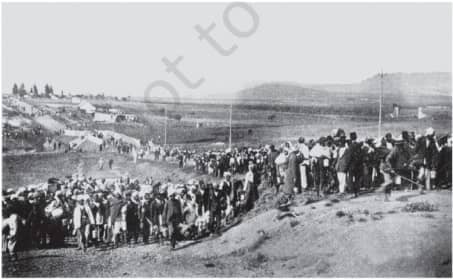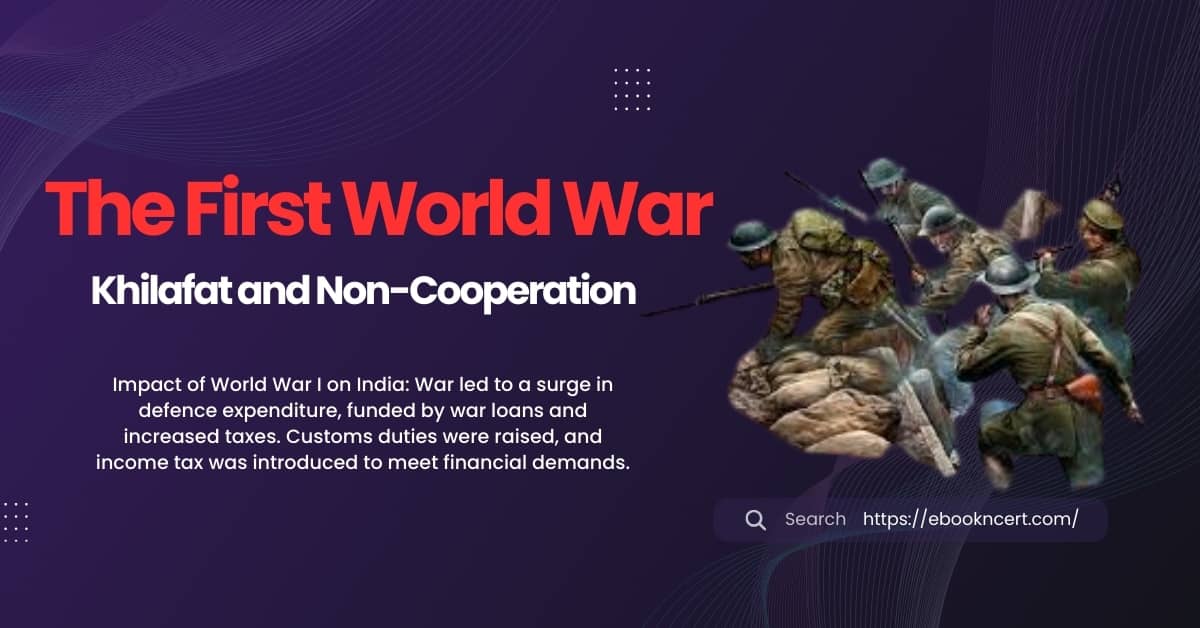The First World War, Khilafat and Non-Cooperation Concept & PDF
Topic & sub-topics covered: The First World War, Khilafat and Non-Cooperation, The Idea of Satyagraha, The Rowlatt Act, Why Non-cooperation?: Nationalism in India (All single detail notes that are exam-oriented).
We have discussed in-depth and exam-oriented pointers that can be asked in the board exam of class 10th about “The First World War, Khilafat and Non-Cooperation” which is taken from the NCERT History book for class 10th chapter no. 2nd “Nationalism in India”.
Download NCERT History Chapter 2 Nationalism in India Class 10th Notes PDF for Free
If you are in class 10th and looking for free NCERT History chapter 2 notes of chapter Nationalism in India class 10 that cover concepts, then From here you can download the free class 10th History chapter 2 notes “Nationalism In India”. You should download this free PDF for future test or exam preparations.
NCERT History Chapter 2 Nationalism in India Notes PDF for Class 10
The First World War, Khilafat and Non-Cooperation
1. Impact of World War I on India:
- War led to a surge in defence expenditure, funded by war loans and increased taxes.
- Customs duties were raised, and income tax was introduced to meet financial demands.
- Prices doubled between 1913 and 1918, causing severe economic hardship for the common people.
2. Recruitment and Anger in Villages:
- Villages faced forced recruitment, contributing to widespread resentment.
- The rural population expressed anger due to the compulsory enlistment of soldiers.
3. Post-War Economic Struggles:
- Post-war, economic hardships persisted, contrary to people’s expectations.
- Prices remained high, intensifying the difficulties faced by the common populace.
4. Agricultural Crises and Epidemic:
- In 1918-19 and 1920-21, widespread crop failures occurred, leading to food shortages.
- An influenza epidemic compounded the challenges faced by the population.
5. Human Toll and Epidemic Impact:
- The Census of 1921 reported a devastating toll, with 12 to 13 million people succumbing to famines and the epidemic.
- The dual impact of food shortages and disease created immense suffering.
6. New Leader and Mode of Struggle:
- A new leader emerged during this challenging period.
- This leader proposed a novel approach to the struggle, offering hope and direction to the masses.
The Idea of Satyagraha
Image Info: Mahatma Gandhi was leading the workers from Newcastle to Transvaal. When the marchers were stopped and Gandhiji arrested, thousands of more workers joined the satyagraha against racist laws that denied rights to non-whites.

1. Gandhi’s Return and Satyagraha:
- Mahatma Gandhi returned to India in January 1915 from South Africa.
- He introduced the concept of satyagraha, a method of mass agitation based on truth and nonviolence.
2. Essence of Satyagraha:
- Satyagraha emphasized the power of truth and the quest for truth.
- It proposed that a just cause could be fought without physical force, relying on nonviolence.
3. Nonviolent Struggle Against Injustice:
- Satyagrahi believed in winning battles against oppression through nonviolence.
- The approach involved appealing to the conscience of the oppressor rather than using violence.
4. Unity Through Dharma of Non-Violence:
- Mahatma Gandhi saw non-violence as a unifying force for all Indians.
- Believed that the dharma of non-violence could bring people together for a common cause.
5. Champaran Satyagraha (1916):
- Gandhi organized a satyagraha in Champaran, Bihar, in 1916.
- Aimed to inspire peasants to resist the oppressive plantation system.
6. Kheda Satyagraha (1917):
- In 1917, Gandhi led a satyagraha supporting Kheda peasants in Gujarat.
- Peasants, affected by crop failure and plague, demanded relaxation in revenue collection.
7. Ahmedabad Satyagraha (1918):
- Gandhi went to Ahmedabad in 1918 to organize a satyagraha among cotton mill workers.
- Demonstrated the versatility of satyagraha as a tool for various causes and communities.
The Rowlatt Act
1. Rowlatt Satyagraha (1919):
- Gandhiji initiated nationwide satyagraha against the Rowlatt Act (1919).
- Rowlatt Act granted extensive powers to repress political activities, allowing detention without trial for two years.
2. Hartal and Popular Uprising:
- Mahatma Gandhi called for a hartal on 6 April 1919 against the Rowlatt Act.
- Rallies, strikes in railway workshops, and shop closures showed widespread public support.
3. British Repression and Jallianwala Bagh Massacre:
- British administration imposed martial law due to fears of disruption.
- On 13 April 1919, General Dyer ordered firing on a peaceful gathering at Jallianwala Bagh, resulting in hundreds of casualties.
4. Government Brutality and Suppression:
- Government responded with brutal repression, including humiliating punishments for satyagrahis.
- Villages were bombed, people flogged, and a wave of violence spread across north Indian towns.
5. End of Rowlatt Satyagraha:
- Jallianwala Bagh incident led to widespread violence.
- Mahatma Gandhi called off the Rowlatt satyagraha to prevent further bloodshed.
6. Broad-Based Movement and Khilafat Issue:
- Gandhiji sought to launch a broader movement in India.
- Recognized the need to bring Hindus and Muslims closer, decided to take up the Khilafat issue.
7. Khilafat Movement and Unified Action:
- Khilafat Committee formed in March 1919 to defend the Khalifa’s powers.
- Gandhi convinced leaders at the Calcutta Congress (September 1920) to start non-cooperation for both Khilafat and swaraj.
Why Non-cooperation?
Image Info: The boycott of foreign cloth, July 1922. Foreign cloth was seen as the symbol of Western economic and cultural domination.

1. Gandhi’s Views in ‘Hind Swaraj’ (1909):
- British rule in India survived due to Indian cooperation, according to Mahatma Gandhi.
- Asserted that if Indians withdrew cooperation, British rule would collapse, and swaraj would be achieved.
2. Non-Cooperation as a Staged Movement:
- Gandhiji proposed a staged approach for the non-cooperation movement.
- It began with surrendering titles, boycotting civil services, army, police, courts, legislative councils, schools, and foreign goods.
3. Civil Disobedience as the Culmination:
- In case of government repression, a full-scale civil disobedience campaign was envisioned.
- The movement aimed to unfold progressively, with each stage building on popular support.
4. Summer of 1920: Mobilizing Support:
- Gandhiji and Shaukat Ali toured extensively during the summer of 1920.
- Their goal was to mobilize public support for the Non-Cooperation Movement.
5. Congress Concerns and Intense Tussle:
- Some Congress members were hesitant about boycotting council elections and feared potential violence.
- Intense debates and conflicts within the Congress between September and December 1920.
6. Compromise at Nagpur Congress (December 1920):
- No initial consensus between supporters and opponents of the movement.
- Finally, a compromise was reached at the Nagpur Congress in December 1920, adopting the Non-Cooperation Programme.
Answer these questions after learning the above topic:
Question: How did the movement unfold? Who participated in it? How did different social groups conceive of the idea of Non-Cooperation?

